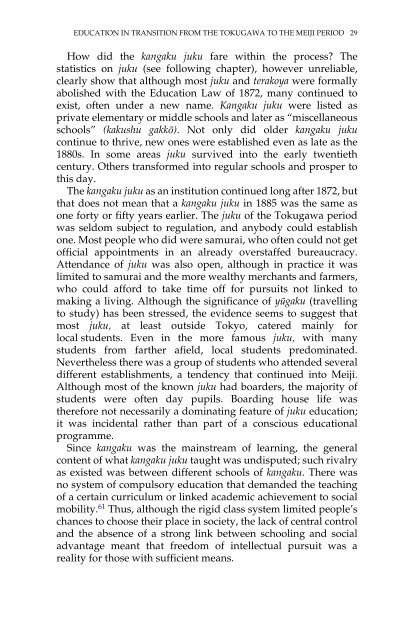Private Academies of Chinese Learning in Meiji Japan: The Decline ...
Private Academies of Chinese Learning in Meiji Japan: The Decline ...
Private Academies of Chinese Learning in Meiji Japan: The Decline ...
Create successful ePaper yourself
Turn your PDF publications into a flip-book with our unique Google optimized e-Paper software.
EDUCATION IN TRANSITION FROM THE TOKUGAWA TO THE MEIJI PERIOD 29How did the kangaku juku fare with<strong>in</strong> the process? <strong>The</strong>statistics on juku (see follow<strong>in</strong>g chapter), however unreliable,clearly show that although most juku and terakoya were formallyabolished with the Education Law <strong>of</strong> 1872, many cont<strong>in</strong>ued toexist, <strong>of</strong>ten under a new name. Kangaku juku were listed asprivate elementary or middle schools and later as “miscellaneousschools” (kakushu gakkō). Not only did older kangaku jukucont<strong>in</strong>ue to thrive, new ones were established even as late as the1880s. In some areas juku survived <strong>in</strong>to the early twentiethcentury. Others transformed <strong>in</strong>to regular schools and prosper tothis day.<strong>The</strong> kangaku juku as an <strong>in</strong>stitution cont<strong>in</strong>ued long after 1872, butthat does not mean that a kangaku juku <strong>in</strong> 1885 was the same asone forty or fifty years earlier. <strong>The</strong> juku <strong>of</strong> the Tokugawa periodwas seldom subject to regulation, and anybody could establishone. Most people who did were samurai, who <strong>of</strong>ten could not get<strong>of</strong>ficial appo<strong>in</strong>tments <strong>in</strong> an already overstaffed bureaucracy.Attendance <strong>of</strong> juku was also open, although <strong>in</strong> practice it waslimited to samurai and the more wealthy merchants and farmers,who could afford to take time <strong>of</strong>f for pursuits not l<strong>in</strong>ked tomak<strong>in</strong>g a liv<strong>in</strong>g. Although the significance <strong>of</strong> yūgaku (travell<strong>in</strong>gto study) has been stressed, the evidence seems to suggest thatmost juku, at least outside Tokyo, catered ma<strong>in</strong>ly forlocal students. Even <strong>in</strong> the more famous juku, with manystudents from farther afield, local students predom<strong>in</strong>ated.Nevertheless there was a group <strong>of</strong> students who attended severaldifferent establishments, a tendency that cont<strong>in</strong>ued <strong>in</strong>to <strong>Meiji</strong>.Although most <strong>of</strong> the known juku had boarders, the majority <strong>of</strong>students were <strong>of</strong>ten day pupils. Board<strong>in</strong>g house life wastherefore not necessarily a dom<strong>in</strong>at<strong>in</strong>g feature <strong>of</strong> juku education;it was <strong>in</strong>cidental rather than part <strong>of</strong> a conscious educationalprogramme.S<strong>in</strong>ce kangaku was the ma<strong>in</strong>stream <strong>of</strong> learn<strong>in</strong>g, the generalcontent <strong>of</strong> what kangaku juku taught was undisputed; such rivalryas existed was between different schools <strong>of</strong> kangaku. <strong>The</strong>re wasno system <strong>of</strong> compulsory education that demanded the teach<strong>in</strong>g<strong>of</strong> a certa<strong>in</strong> curriculum or l<strong>in</strong>ked academic achievement to socialmobility. 61 Thus, although the rigid class system limited people’schances to choose their place <strong>in</strong> society, the lack <strong>of</strong> central controland the absence <strong>of</strong> a strong l<strong>in</strong>k between school<strong>in</strong>g and socialadvantage meant that freedom <strong>of</strong> <strong>in</strong>tellectual pursuit was areality for those with sufficient means.













